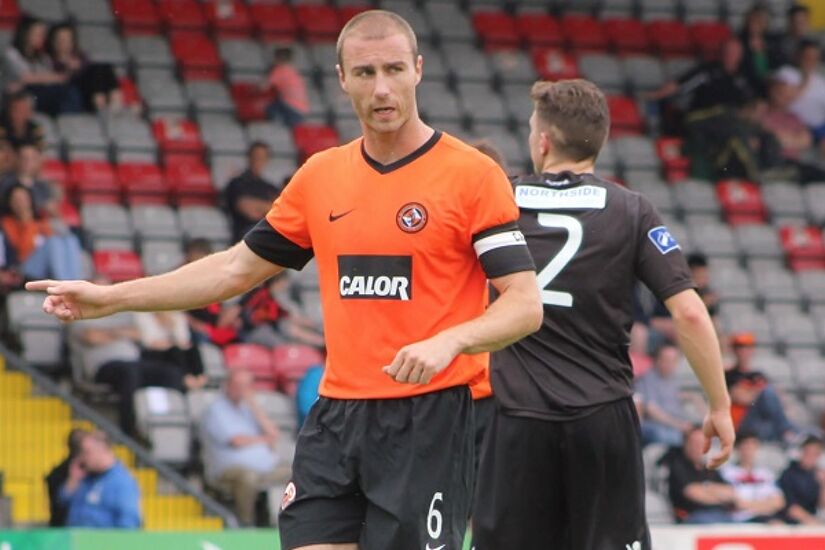Sean Dillon: 'Everybody that signed was told, this is a shop window to go on to bigger and better things'

Credit: Jason O'Callaghan (ETPhotos)
When Sean Dillon signed for struggling Dundee United in January of 2007, he never expected he'd be lining out for his testimonial at Tannadice ten years later.
The Dubliner lasted just a few seconds of the clash with Hearts, having injured his ankle against St Mirren the previous weekend, as 3,000 fans turned out to honour their captain.
The former Longford Town and Shelbourne defender has worn the armband at for the past three-and-a-half injury-interrupted seasons, a sign of both his seniority and clear leadership qualities.
Last year, he was inducted into the club's hall of fame – the only currently active player to receive that honour – and was last night honoured with a testimonial for his 10 years of service.
“I've been lucky. I've always considered myself lucky to be playing [here] that long,” Dillon told extratime.ie from the comfort of the team bus earlier this year.
“I like the area and I get on really well with the guys at the club. I've a big relationship with everybody here.
“Obviously, when I first came over, I'd be lying if I said I imagined myself still being here at this stage.
“I suppose you just renew your contract, then you renew another one, and before you know it you realise actually how long it is.”
On signing, the then-23-year-old Dillon certainly had aspirations of playing at a higher level, but it was the financial implosion at Shelbourne that forced him to speed up the transition.
Having played schoolboy football with renowned Dublin nursery Cherry Orchard, Dillon signed forms with Aston Villa as a 16-year-old and uprooted to Birmingham.
After three years in the UK, Dillon returned to Ireland and signed for Alan Mathews at Longford Town and helped backbone the most successful period in the club's history.
Dillon won two FAI Cups and one league cup winner's medal with the midlands club, and played in the UEFA Cup as Town finished no lower than sixth in the table during his tenure.
In 2006, Pat Fenlon signed him for Shelbourne and the success continued as the Reds clinched the title on goal difference from Derry City with a final-day win over Bohemians.
The cracks had already begun to show at Tolka Park – and not just in the stands – as the squad rallied to seal the championship despite regularly going unpaid.
Shelbourne were relegated before the beginning of the next season, but Dillon had already moved on at that stage and settled on Dundee United as a possible stepping stone.
“Craig Levein was the manager. Everybody that signed in the first year or two that Craig was there was basically told, 'listen, this is a shop window for you to go on to bigger and better things.'
“I wouldn't necessarily say I had a certain plan, but I was keen to make sure I could play at this level initially before I started thinking about going anywhere else.
“The way things finished up at Shels was obviously very disappointing, considering we won the league, and for things to fizzle out the way they did was a real shame.
“It was a great experience for me being there, a great squad and great stuff. Everybody at the club was amazing. Unfortunately, that's the way it ended.
“It wasn't great, but it gave me the opportunity to come back to Britain again, and obviously I'm glad I did.”
While Dillon's ten years in Scotland have, for the most part, been marked with steady improvement, 2015-16 saw the club relegated to the second tier for the first time in 20 years.
Under Levein, and later Peter Houston and Jackie McNamara, United built a solid core of young players, many of them Irish.
Alongside Dillon were, at various times, Jon Daly, Willo Flood, Gavin Gunning and Noel Hunt.
Barry Robson, Gary Mackay-Steven and Andrew Robertson became regular internationalists for Scotland while playing at Tannadice, before the former pair moved onto Celtic.
Wherein lies one of the key differences between the Scottish Premier League on one hand and, on the other, the League of Ireland.
While the big clubs in Ireland can sometimes sign high-performing players from other sides in the Premier Division, in Scotland the power of the big two is much more acute.
The Tangerines were three points off leaders Aberdeen on New Year's Day in 2015 until key players Mackay-Steven and Stuart Armstrong agreed mid-season moves to eventual winners Celtic.
United lost 10 of their remaining 19 games, winning just five, to finish in a disappointing fifth position.
The decline continued into the following season as Mixu Paatelainen replaced Jackie McNamara at the helm and presided over a bottom-placed finish.
“It's very hard to take a positive from being relegated.
“The way things have been since I came here up until last season every season we've been in the top six in the league, finishing in various positions from sixth fifth, fourth and third.
“It's very difficult to take a positive from being relegated from our point of view, and we're desperate to make sure that we're only spending the one season here.
“It's hard to take positivity from the relegation, but it's done, and the only way of getting back up is to look forward and make sure we learn from the mistakes of before.”
On the home front, the success – and not only the success, but the style – of Dundalk in Europe last season has opened up the eyes of many to the quality in the League of Ireland.
Daryl Horgan, Andy Boyle and Gary Rogers all earned international call-ups on the back of their performances at home and abroad for the Lilywhites.
The thorny issue of how the top Irish teams compare to other leagues – particularly those across channel with demanding schedules and large squads across the board.
The Shels team Dillon played in under Pat Fenlon was arguably the closest, in terms of budget, preparation and quality of playing squad, the League of Ireland has come to a fully professional outfit.
And for Dillon, it's not a question that can be easily answered, but United's struggles in the Scottish Championship – they lie fourth, 11 points behind leaders Hibernian – are demonstrative.
“I've had it a long time, people saying 'how do you describe the difference between the leagues?'
“It's very difficult to compare a Celtic or Rangers, maybe, to one of the smaller Scottish teams but I definitely believe it's a step up [from Irish football].
“In general, if you look over the course of a season, I think it was definitely a step up for myself, but I have a lot of time for the league back home.
“Any time the Celtic and Rangers thing is brought up about competing down in England, everybody has a view on it. What I would say about Dundalk is that they have been very, very impressive.
“I don't know Stephen [Kenny] very well, but Vinny Perth is a good friend of mine who I speak to pretty regularly.
“They've been very impressive in the games that I've been able to watch, and you've only to look at some of the boys that have went on and been involved in the senior international team and have got moves.
“It's very difficult to say how well they would go in another league – it's impossible to give an opinion on – but they're obviously a very good side and they've proved against big clubs in their group in the European games they're certainly good enough.”
Should the Tangerines fail to win promotion at the first attempt, Dillon may have opportunity to test the theory out for himself as soon as this calendar year.
The lower-tier trophy – which encompasses all league clubs, Premiership under-20 sides and two each from Wales and Northern Ireland – will next year feature Sligo Rovers and Bray Wanderers.
United face St Mirren in the final of this year's iteration on Saturday.

